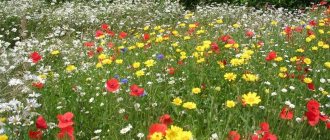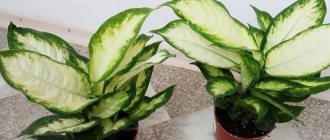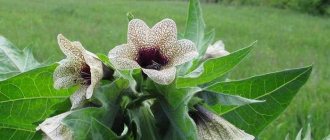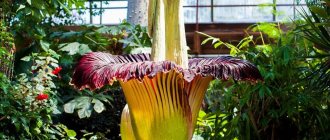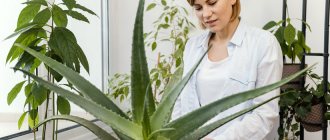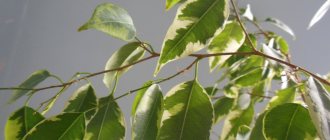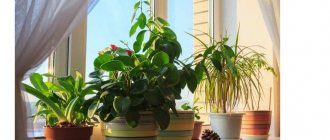When choosing plants to grow at home, first study the features of their content and appearance.
This allows you to make the right choice: determine the most attractive flower that is easy to maintain, relying on your own knowledge and skills.
But not all varieties are suitable for an apartment or house. There are plants that contain poison, release harmful substances into the environment, or otherwise affect humans.
When there are children or one of the family members is allergic, you need to be more careful about the question of which flowers should not be kept in the house.
Pay attention to the external signs of such plants in order to recognize the danger in time.
Dangerous flowers containing poison
What flowers should not be kept at home
Among the most dangerous are more than 15 varieties of flowers that people unknowingly grow at home.
Often such plants have an attractive appearance, so it is not always possible to understand that the green mass contains toxic substances.
35 flowers and plants that should not be kept at home:
- Dieffenbachia;
- Oleander;
- Croton;
- Spurge;
- Ivy;
- Mimosa bashful;
- Azalea;
- Philodendron;
- Monstera;
- Adenium;
- Nightshade;
- Stellera dwarf;
- Primrose;
- Alocasia;
- Trichocereus;
- Gesner Tulip;
- Aglaonema;
- Cyclamen;
- Browallia;
- Gloriosa;
- Spathiphyllum;
- Poinsettia;
- Begonia;
- Pachypodium Lamera;
- Clivia;
- Ficus;
- Fern;
- Lily;
- Orchid;
- Hydrangea;
- Dracaena;
- Crassula;
- Geranium;
- Rose;
- Sansevieria.
Dieffenbachia
It has a bright appearance: it reaches 2 m in height (some of the species), the leaves are large, variegated yellow-green.
Dieffenbachia
grows quickly and loves a humid climate. These signs make Dieffenbachia attractive to gardeners, but when the leaf is damaged, poisonous juice is released.
If it gets into the child's body, there is a high risk of poisoning. The plant can burn the outer coverings. The poison causes burns and irritates the outer skin.
Oleander
The shrub can reach 5 m in height, but indoor varieties are small - up to 50 cm. Its leaf shape differs - they are narrow and long.
Oleander
Oleander flowers come in different colors. Among them there are flowers with double petals. Ovaries appear during the warm period, but at different times, depending on environmental conditions.
The danger of oleander lies in the high probability of poisoning. A negative reaction can occur upon contact with any part of the plant.
Croton
The flower looks attractive: a lush bush, variegated leaves with patterns of different shades.
Croton can reach 2 m in height, but at the initial stage of development it is compact. Croton
The shades, like the shape of the leaves, are always different. Thanks to this, many gardeners do not pay attention to the poison contained in the plant and grow it at home.
Croton's ability to mutate also seems attractive; there is still no explanation why the leaves take on different shapes.
Be careful: The toxic substance, if ingested, causes vomiting, diarrhea, and contact dermatitis. You should not inhale it or otherwise come into contact (while caring for the plant).
Spurge
Presented in a large number of varieties.
The flower received its name due to the release of a substance of a special structure and external characteristics: viscous, white, reminiscent of milky juice. Euphorbia
Among the varieties of milkweed, there are those that contain thorns. Given its dangerous properties, the flower has gained a reputation for bringing misfortune.
Keeping it at home is also dangerous because of the poisonous juice contained in the green mass.
Euphorbia is small in size, found in the form of a bush, less often in the form of a tree.
The stems and leaves are often fleshy, differ in shade, and in some varieties you can see a specific pattern on them. Euphorbia blooms, the shade of the petals varies depending on the species.
Ivy
The name of the plant is reminiscent of the vines that are found on the facades of buildings. But there are also indoor flowers of this species.
Among them are hedera and others. They are evergreen shrubs and climb, but this does not prevent you from growing such plants at home.
Ivy
You just need to give the desired shape to the vines. The flower loves cool, moderately humid air and needs good lighting.
The leaves have a specific shape: three- or five-lobed, different colors; some types of ivy have a noticeable pattern of a different color.
The length of the vine sometimes reaches 20 m. There are also species whose roots develop above the ground. They act as a support for the vines.
Expert opinion: The plant is easy to grow, which attracts gardeners, but some varieties contain poison. After flowering, berries may appear; they are the most dangerous for humans.
Mimosa bashful
The flower is known for its connection with the energy of the earth's core, which is expressed in the constant movements of the leaves, which do not depend on lighting, watering or other external factors.
Mimosa pudica
The flower received its name due to its ability to close its leaves when touched or exposed to another irritant. This is a perennial plant reaching 70 cm in height, often smaller, but there are also varieties up to 1.5 m.
The leaves have sensory areas that respond to pressure. The ability to roll leaves is due to the need to receive moisture.
It reaches the membrane at the base of the leaf in a special way. When the water drains, it curls up, keeping the liquid inside and nourishing the plant.
Upon contact, an odor of hydrogen sulfide may occur. But that's not all the dangers. Mimosa is a poisonous plant. It is dangerous to grow it at home, as there is a risk of poisoning.
Dangerous for animals: If the plant is found by animals in the pasture, they can also receive a dose of poison, which will lead to negative consequences.
Azalea
The plant is a perennial and belongs to the Heather family. At home, flowers are found in the form of shrubs, up to 50 cm in height.
Azalea
The color of the petals can be different: white, pink, red, purple. The leaves are unusual - elliptical in shape with a glossy sheen.
When growing at home, it is necessary to create special conditions: the air must be cool and thoroughly humidified.
What is the danger: Azalea contains a neurotoxin - andromedotoxin. Moreover, it has a narcotic effect.
Philodendron
Philodendron is native to countries with tropical climates. There are more than 900 species. Philodendron is a perennial plant. It is distinguished by its unusual leaf shape.
Moreover, it varies depending on the type of flower.
Philodendron
The main source of nutrition is the root system. The stems are fleshy and tend to become woody.
In its natural environment, Philodendron has a significant leaf length - up to 2 m. Climbing or warty Philodendron is grown at home.
However, this beautiful plant is poisonous.
The juice contained in the green mass can cause severe inflammation of the mucous membranes upon contact with it. Even bloody discharge appears in these areas. And when it enters the stomach, the poison provokes a disorder.
Monstera
The flower comes from countries with a tropical climate. Reaches a significant height, the length of the leaves is significant - up to 45 cm.
Monstera
The shape is different, depending on the type of flower. But most often you can see numerous cutouts on the leaves.
The houseplant, like its wild varieties, reaches the ceiling when grown indoors. The flower does not tolerate direct exposure to sunlight, but prefers high humidity.
Monstera is a poisonous plant that releases a toxic substance that can cause a strong negative reaction, which is due to the content of oxalate formations.
Shrub Adenium
Shrub or woody succulent (depending on the variety). House plants reach 35 cm in height. Moreover, the trunk is quite thick, while the leaves, on the contrary, are often small.
Adenium
Flowers of different shades, sometimes white and crimson. The popular name is “desert rose” .
Adenium loves warm climates, sometimes blooms for 6 months, but more often in spring or autumn. Adenium comes from the tropics, so it is a heat-loving flower.
Contains milky juice, like spurge. But such a plant is distinguished by the high toxicity of the secreted substance. For this reason, care should be taken to study which flowers cannot be kept at home; indoor flowers of other types are more preferable.
Nightshade
The flower is represented by a large number of species - up to 1700. It comes from countries with a tropical climate, but also grows in regions with a temperate climate.
Nightshade
You can find trees of this group, as well as shrubs. Among the varieties there are also domestic ones. Nightshade is distinguished by its unusual development - it begins to bloom in February, when many plants have not yet completed their dormant period.
Nightshade differs in its stem: it can be erect, lying, or creeping. The flowers are collected in panicles or racemes and may be covered with shields.
Varieties containing poison in all parts of the plant can be grown at home, but eating its fruit is prohibited. They are also bitter - this is a natural defense.
Expert opinion: As long as the plant is not damaged, it will not cause harm. But it is better to care for it with impenetrable gloves.
Stellera dwarf
The plant bears fruit. It is classified as perennial. Moreover, Stellera is distinguished by a thick root, many leaves and unusually shaped flowers that rise above the erect stem.
Stellera dwarf
Note: The plant is poisonous, contains anthraglycosides, organic substances (acids). Despite this, in some countries it is used in folk medicine (stellera has a laxative effect and helps with constipation).
Primrose
Primrose prefers a humid climate. Most often it blooms in the spring, but among the varieties of primrose there are summer-blooming ones.
Primrose
The plant is a perennial, reaching a height of 30 cm. It is distinguished by a variety of shades of petals: yellow, burgundy, blue, white, etc.
It prefers a temperate climate, so it is often found in the countries of the Asian and North American continents. Flowers are formed in inflorescences - there are up to 20 in one.
What is dangerous for humans: The plant protects itself - upon contact with the leaves, signs of dermatitis may appear. This is due to the poison content in the glandular hairs.
Alocasia
Alocasia reaches 2 m in height. There are small varieties - up to 40 cm. The fact that the plant is poisonous can be guessed by the shape and color of the leaves.
Alocasia
They are spiky, with bright, contrasting colors. The plant comes from countries with a tropical climate, so it prefers hot, humid air. Alocasia is a perennial flower. He is considered one of the most dangerous.
Expert opinion: Upon contact with such a plant, the process of destruction of the outer integument begins, and bloody discharge with an unpleasant odor appears.
Trichocereus
The cactus is represented by a large number of species that differ in external characteristics. In the natural environment it reaches several meters (sometimes up to 12 m).
Trichocereus
At home, it is not possible to grow a cactus larger than 1 m. What unites different types of Trichocereus is its round shape and ribbed surface.
Branches may appear - lateral branches. During the flowering period, a tube grows, with a flower on it. A special feature of the cactus is the time it opens - at night, and the smell is very pleasant.
The cactus is known as a hallucinogenic plant. The secretion of poisonous juice is a way of protection.
Gesner Tulip
The height of the flower is up to 40 cm. It was included in the Red Book due to its gradual disappearance in nature.
Tulip of Gesner
There are plain tulips and variegated ones (of different shades). They begin to bloom towards the end of spring.
Seeds are used for propagation, which distinguishes the Gesner tulip from representatives of other species (garden).
Why the flower is dangerous: The advantage is the long flowering period - up to 3 weeks. It is believed that staying in the same room with such a plant can cause baldness.
Aglaonema
It belongs to the subshrubs and is an evergreen flower. It is distinguished by large leaves - 15 cm long, of different shades, depending on the species.
Aglaonema
Reaches 70 cm in height. You can’t count on flowering, because this rarely happens. But sometimes, with proper care, an inflorescence ear still appears.
Only the flowers on it are rather inconspicuous. The plant bears fruit. Despite the fact that the flower does not emit a toxic substance, it is still recommended to come into contact with it with caution.
The fruits are more dangerous; they contain juice that can cause burns to the mucous membrane.
Cyclamen
Cyclamen is called Alpine violet. Its flowers appear on thin stalks. Cyclamen is attractive, and thanks to its flowering in the autumn-winter period, it will delight household members when most plants are in a dormant period.
Cyclamen
There are different types of this flower, which determines the shade and shape of the petals. When grown indoors, it prefers cool air.
Despite its attractive appearance, you cannot behave carelessly next to such a flower. There is a risk of burns to the mucous membranes. At the same time, the temperature may rise significantly, making breathing difficult.
Be careful! The most dangerous parts of the plant: seeds, roots.
Browallia
The attractiveness is due to the many small flowers that appear against the background of dense green mass.
The plant is distinguished by its small height - up to 30 cm. Brovallia
Thanks to its modest beauty, the flower can compete with bright exotic varieties. The leaves are pointed and small. Their rich color emphasizes their attractiveness.
The flowering period begins in summer, but continues until the first frost. All parts of the plant pose a threat to living things. According to experts, you should not allow contact with it without protecting your skin.
Gloriosa
Gloriosa is called the queen of flowering vines. It is considered the official flower of Zimbabwe, and it belongs to the vines, the length of the stems does not exceed 50 cm.
Gloriosis
The root system develops in a horizontal plane. During the flowering period, the plant can be mistaken for a lily, due to the similarity of the petals.
They are distinguished by a wavy edge and the ability to change shade. Initially the flowers are yellow, gradually turning red.
Gloriosis is dangerous to humans. It is not recommended to grow it at home if there are children or any family members suffer from allergies.
Expert opinion: If the poison contained in all parts of gloriosa enters the body, diarrhea, vomiting, weakness may appear - all signs of allergies and poisoning.
Spathiphyllum
Spathiphyllum does not require careful care, but at the same time, without proper attention, the flower may die.
Spathiphyllum
Spathiphyllum has a bright appearance: it has pointed large leaves, the spathe of the yellow inflorescence is characterized by a white/green color.
The plant prefers moderate air temperatures. Experts do not recommend placing it in the shade; the best place is a south-facing window, and at a distance of 1-2 m from it.
Spathiphyllum is dangerous, or rather, its juice: when it gets on the mucous membrane it causes irreversible processes, and on the skin it provokes the appearance of ulcerative formations.
Poinsettia
Poinsettia belongs to the Euphorbiaceae family. It is distinguished by its attractive appearance and the appearance of flowers at Christmas.
Poinsettia
Poinsettia in natural conditions can grow up to 4 m, but at home it barely reaches 0.5 m. The bracts and leaves have a similar shape - wide, pointed.
They differ in shade. Thus, the leaves are rich green, and the bracts can be of different colors (white, yellow, red), which creates contrast and at the same time attracts attention with the unusual color.
Expert's opinion: Poinsettias do not emit a dangerous odor, but they do contain poisonous sap. The substance is released if part of the stem is broken. As soon as a whitish liquid appears, you should wash your hands.
Begonia
It is somewhat reminiscent of pounsettia, but instead of bracts of a contrasting tone, inflorescences of a bright shade appear. They are concentrated in the upper part, deep green leaves appear at the bottom.
Begonia
There are about 2000 species of this plant. The majority are native to countries with a tropical climate. Begonia needs a period of rest.
Among the varieties there are bushy, tuberous, evergreen flowers. The height of the plant, as well as the shade of the flowers, differs and depends on the species.
Why it is dangerous: If you accidentally consume part of a begonia, you can get swelling of the larynx, but the pathological process begins with a burn of the mucous membranes.
Pachypodium Lamera
In its natural environment it grows in areas with an arid climate. There are only 23 species of Pachypodium. Among them there are cactus-like plants. But there are also small bottle-shaped trees.
Pachypodium Lamera
The main feature is the presence of spines. The plant got its name due to the peculiarity of its appearance: the leaves grow on a thick stem.
In the natural environment, the height reaches 8 m. At home, pachypodium is usually grown in small sizes - up to 1 m.
The sap is usually clear, not milky, like many poisonous plants. But this liquid still poses a danger. However, it causes harm provided that the skin is damaged.
Clivia
Clivia is native to South Africa but is native to temperate climates. The flower is attractive and does not require careful care.
Clivia
Main characteristics: long narrow leaves, bright flowers. Moreover, the plant improves its characteristics as it develops.
The lifespan of clivia is 40 years. Flowering begins in late winter, early spring.
Expert opinion: Clivia belongs to the group of plants with the loud name “killers”. If the poison contained in the roots and leaves enters the child's body, it can cause paralysis.
2.Beaumontia grandiflora
Despite the fact that this oriental beauty has become widespread and has taken root well in coastal regions, its juice has long been used as poison, which makes beaumontia one of the most poisonous indoor plants. Its use was very popular to cause mental disorders and heart attacks in unfaithful husbands in medieval South Asia, as well as to kill unwanted guests. The tips of the darts were generously moistened with Beaumontia juice, after which they were imperceptibly thrust into the body of the victim, who lost consciousness and did not resist violence or theft of property.
Moderately dangerous plants
Some of the flowers can be considered moderately dangerous. Even if they contain harmful substances, even if they enter the environment they do not cause serious harm.
They may cause illness, but do not pose a threat to life and health. Still, you should know which flowers should not be kept at home, and why, in order to avoid negative effects, even to a small extent.
Ficus
Information often appears about the dangers of Ficus. According to experts, this is not entirely true. More precisely, ficus is dangerous only for some creatures - cats.
Ficus
The plant does not pose a direct threat to people, because it does not contain toxic substances. But ficus can cause a negative reaction from the body, since it belongs to the group of allergens.
It is better not to grow a plant of this species at home where a cat lives. This is due to the fact that if ficus juice enters the animal’s body, vomiting may occur. The reason is the strong bitterness of the plant liquid.
Fern
Domestic varieties of this plant seem harmless, but they can cause harm, although not too much.
Fern
Experts do not recommend placing a fern in the bedroom, next to the bed. However, this recommendation applies to most indoor plants.
But ferns can have an effect on the body similar to that of lilies: they release carbon dioxide, the excess of which often causes headaches.
Lily
Lily can cause discomfort due to different properties.
First of all, the content of a high amount of essential oils is noted. Their concentration is so high that in the late afternoon the smell of lilies can be felt at a distance of more than 10 m. Lily
If the plants exude the aroma in the room, it will intensify many times over. This content of essential oils causes headaches.
A similar result can be obtained thanks to the processes occurring in the tissues of the plant - the lily releases carbon dioxide, converting it from oxygen. As a result, your head may hurt.
Orchid
The flower is not dangerous and does not directly harm humans. But it is recommended to grow only certain species at home.
Orchid
It is believed that the orchid is something like an energy vampire - it contributes to the deterioration of well-being.
A person may feel unwell or have a headache for no apparent reason. Some plants emit aroma of varying intensities.
The stronger the smell, the worse your headache may be.
Hydrangea
Hydrangea is classified as moderately poisonous. Causes more harm than fern or orchid: it contains poison - cyanide, but in small concentrations.
Hydrangea
Moreover, it enters the body when consuming flowers and buds. As a result, the functioning of the cardiovascular system may be disrupted, and under the same conditions food poisoning develops.
Loss of consciousness is possible, and convulsions occur.
Dracaena
The flower cannot be called particularly dangerous.
Dracaena
It does not contribute to the development of allergies under normal conditions, but, like any plant, it releases substances during its life, which means that a certain amount of allergens can still enter the air.
There is also a risk of developing an individual reaction when inhaling spores of the fungus that develops in the soil on the leaves, so it is important to provide quality care.
Crassula
It is believed that the money tree harms the energy of the home. But lovers of this plant also know other facts - the fat plant contains arsenic. Moreover, its quantity is significant - a couple of leaves are enough to poison yourself.
Crassula
Vomiting, diarrhea appears, and the person may even lose consciousness. And esotericists talk about the need to compensate for the feminine energy that the money tree carries.
Note: To do this, there must be plants with masculine energy in the house, which will allow you to achieve balance.
Geranium
Geranium is classified as moderately dangerous. It is not recommended to grow it where children, pregnant women, and elderly people live.
Geranium
Geranium is a strong allergen that can cause serious health problems. Also, the composition of plant tissues includes substances that help change the properties of blood.
Geranium affects its thickness. Those who have thrombophlebitis should not consume this plant in any form.
1.Dieffenbachia
It was brought from tropical forests and took root thanks to its unpretentiousness and excellent adaptation to the harsh weather conditions of our homeland. However, Dieffenbachia juice is extremely poisonous to humans and has even been used as an instrument of torture. Once it gets on the mucous membranes, it burns and paralyzes them, so if you rub your eyes you can easily lose your sight. During slavery, planters forced the most talkative people to chew the leaves of the plant, which caused their tongues to swell and the ability to speak to be lost, for which Diffebnachia was nicknamed the “dumb rod.”
Plants and signs
There are also flowers that do not harm anyone, but for some reason they are classified as plants that can foretell the future and indicate future events. People interpret the meaning of colors in different ways.
Rose
It is recommended to grow such flowers for those who are not often at home.
The reason is the special impact on humans. Rose
It turns out that rose affects energy and helps reduce vitality. An already weak person will be weakened even more.
The more pots of roses you have at home, the worse it gets. The best option is to grow such plants outside: in the yard, on the terrace.
Sansevieria
The flower does not fit with male energy. It is not recommended to grow it where a man lives.
Sansevieria Sansevieria
is also not suitable for a lonely girl - it will drive away suitors. Otherwise it is a harmless, beautiful flower.
No one would have thought that it had such an unusual effect on a person.
Let's sum it up
The listed plants have different properties. Moreover, they are all so attractive that you want to arrange a winter garden on your veranda at home or on the balcony of your apartment.
But roses, geraniums, spathiphyllum, dracaena and other flowers can have a negative impact on health.
To prevent the development of allergies, poisoning, and other consequences, you need to know exactly which of them should be grown and which should not.
7. Epipremnum
Like other representatives of the aroid family, epipremnum automatically falls into the list of the most poisonous houseplants on the planet, but it does not pose a great danger to humans, unless you are planning to soak your hands in its juice and then rub your eyes: then you are guaranteed to have conjunctivitis, at a minimum. and complete loss of vision at maximum. However, if you have pets, especially cats, then we do not recommend getting epipremnum, since by biting off its leaf, the animal risks burning the mucous membrane, which can lead to pain during consumption of food and even suffocation.
8. Cycad drooping
Many generations of researchers suffered from severe poisoning from the poison of this plant. The fact is that the natives were well aware of the toxic properties of the cycad and widely used it as a poison, offering it to newly arrived adventurers as a treat. Therefore, most of the tribes of New Guinea and the Malay Islands managed to maintain their own way of life for many years, and in the era of globalization, take advantage of the Europeans’ craving for the exotic and export one of the most poisonous houseplants. But remember that the potential to harm your own health still remains, so try to work with cycads with gloves and avoid getting the juice in your eyes and mouth.
Scheffler
This flower belongs to the conditionally poisonous plants. Tissue sap in direct contact with human skin causes a local inflammatory reaction in the form of redness, tissue swelling, pain and burning.
In individual cases, a pinpoint rash may appear at the site of suspected contact. You can stop the further development of the reaction by washing your skin with soap.
Features of care
A houseplant does not require any specific growing conditions. But still, in order for the flower to be comfortable, it needs to be provided with appropriate care.
Watering. Euphorbia does not like overwatering; this can cause it to die. In hot weather, watering is increased, but the soil is not allowed to become waterlogged. In autumn and spring, soil moisture should be minimal. Some types of indoor milkweed do not need watering in winter, while other plants wither if the earthen ball in the pot dries out. Humidity. Undemanding spurge grows well in conditions of low or high humidity. Of course, it is best to create average air humidity parameters for it, but if this cannot be done, then nothing bad will happen to the flower
Important! If the plant is in conditions of low humidity and low air temperature, then there is a risk of rotting of the root system or wilting and subsequent loss of leaves. Air temperature. Euphorbia is more of a heat-loving flower.
It will develop comfortably at air temperatures from +18 to +25 degrees. In summer, the plant can be placed on the balcony, but it cannot be left outside if the air temperature drops to +12 degrees. Lighting. Depending on the variety, the flower must be provided with either regular exposure to sunlight, partial shade, or diffused light. Location. Most often, spurge is placed on windowsills. Large flowers are placed on the floor. It is important that the plant is protected from drafts. Euphorbia also does not like “neighborhoods” near heating devices. Priming. For indoor milkweed, it is advisable to purchase a special soil mixture labeled “For succulents” or “For cacti.” The pot must have a drainage layer. Fertilizers. During the period of vegetative growth, fertilizing is applied to the soil once every 2 weeks. The ideal option is specialized fertilizers for cacti or succulents. Flowering forms of milkweed require fertilizing, including potassium. In autumn and winter, fertilizing stops. Pots. An excellent option for growing milkweed is a clay or plastic pot. The plant will feel comfortable in a shallow but voluminous pot.
Adenium
A slow-growing houseplant, represented by a beautiful tree or shrub with a very thick trunk. It always has a slight thickening, as well as numerous short branches.
Adenium has many names - in a number of countries it is called Desert Rose, Star of Sabinia or Impala Lily (see photo). Despite its decorative nature, it is easy to care for and is suitable for beginning gardeners. More than 50 species have been bred, differing in appearance and height.
Adenium is also known for the fact that the harmful juice of this plant was used by some African tribes to impregnate hunting arrows. When the plant is damaged, a strong toxin is released that affects the functioning of the nervous system. It is highly not recommended to keep the flower in a child's room to avoid poisoning. When cleaning, you should wear gloves and wash your hands and tools thoroughly after contact.
First aid for accidental poisoning
Of course, at the first symptoms you should visit a doctor in the emergency department. However, every parent can take a number of initial measures in case of accidental poisoning with poisonous house flowers:
- Rinse the affected area with running water to stop further spread of toxins.
- Rinse your mouth with clean water to remove pieces of the eaten plant.
In case of poisoning by some types of indoor plants, these actions will be sufficient, and specialized medical care will not be needed. For the majority of food poisoning, completely different measures are required, which can only be provided in a hospital setting.
Reproduction methods
Desert rose can be grown and propagated in several ways:
- Seeds. A necessary condition is the availability of fresh seeds.
- By cuttings. Using a cut.
- Vaccination. Using the circular cut method.
- By layering. With the help of a rootstock.
The following conditions are required for reproduction:
- Comfortable temperature (+25… 30 °C).
- Proper lighting (south or east side in the house).
- Twelve hours of daylight.
- Light soil that provides access to oxygen, a good drainage layer.
- Dosed watering.
Seeds
The optimal time for sowing is the end of winter and the beginning of spring. The temperature must be above 25 °C.
Instructions:
- Seeds should be filled with Epin solution.
- Wait six hours.
- Then put them in a mixture of sand and vermiculite.
- Seeds should be spaced at a distance of 3 cm.
- Cover them with a substrate 5-10 cm thick.
- After seven days, you can observe the appearance of the first shoots.
Apical cuttings
In the spring and summer seasons, the plant can be propagated by apical cuttings. Winter is not a suitable period for the procedure. The length of the cutting should be 10-15 cm. The cut edge is treated with charcoal, and the cutting itself is dried. With the correct humidity (75-80%), temperature +25... 30 °C, sufficient lighting and quality soil, the plant will take root within a month.
Air layering
This is a method that is suitable for both young and adult plants. The procedure should be carried out with the onset of heat.
Recent Entries
Chainsaw or electric saw - what to choose for the garden? 4 mistakes when growing tomatoes in pots that almost all housewives make Secrets of growing seedlings from the Japanese, who are very sensitive to the soil
Step-by-step instruction:
- Choose a shoot measuring 20 cm.
- Make a round cut on it.
- Dry.
- Treat with a root stimulator.
- Wrap the cut with sphagnum moss.
- Wrap in a dark film that does not allow light to pass through.
- Moisten the moss regularly.
- After 14-20 days, roots will appear and the plant can be planted in the ground.
The method has a slight drawback: the trunk will not be as thick as that of obese adenium.
With the help of vaccination
There are two effective ways to propagate desert rose using grafting:
- Flat. It is less traumatic. The place of the rootstock on the parent tree is not damaged; the cutting itself has only one cut, through which it fits tightly to the desired place. The branch should be taken with a diameter larger or equal to that of the scion itself.
- V-shaped. The apical part should be removed from the branch intended for the rootstock. The resulting stump is split and a prepared cutting with symmetrically cut edges on both sides is inserted into the resulting gap.
The vaccination site must be secured with a cloth bandage or adhesive tape. After a successful procedure, the auxiliary material is removed, being careful not to disturb the junction until complete fusion. Flowering occurs within a few months.
Flat grafting
Flat grafting
V-shaped grafting
Ivy
This is a common perennial vine-like plant, often used to decorate walls and facades. Ivy is known for its antibacterial properties and actively destroys fungi and pathogenic bacteria. At the same time, all parts of the plant are poisonous, especially young fruits and stems.
If the fruit enters the human body, it causes severe poisoning. Flowering at home is rare, and when buds appear, it is recommended to remove them.
Pachypodium (Madagascar palm)
One of the most famous indoor palm trees, although it has nothing to do with this type of plant. Due to the dense stem and wide spreading crown, the flower is often called “thick leg”, which is a literal translation from Greek. In nature it grows up to 8 meters, domestic specimens are significantly smaller - up to 1.5 m. Today, a large number of dwarf varieties have been bred, distinguished by their decorativeness and compact appearance.
Even with minor damage to the leaves or stem, a milky sap appears on the plant, which does not pose a threat to the health of the body. The toxin is dangerous only if it gets into open wounds or mucous membranes. It is not recommended to keep pachypodium in a child's room or in places accessible to pets.
Crassula
In folk medicine, there was also a place for compresses from this plant. It is recommended to use local treatment for inflammatory processes on the skin and articular surfaces.
However, the tissues of the Crassula contain large amounts of arsenic. If you accidentally consume such a “delicacy” in food, after 0.5-1.0 hours a picture of food poisoning with symptoms of intoxication will develop.
9.Hydrangea
Oddly enough, the most beautiful plants are also the most deadly. Hydrangea, so familiar to us, contains acid that can cause difficulty breathing, heart rhythm disturbances, hallucinations, disruptions in the central nervous system and even death, however, only when trying to eat the plant. Therefore, make it inaccessible to children and pets, because sometimes a situation may arise when you simply cannot provide the necessary assistance in a timely manner. And we recommend wearing gloves when planting, because hydrangea can cause an allergic reaction in many people, especially during the flowering period.
10. Zamioculcas
Despite the huge number of rumors surrounding this species, it is very difficult to call it the most poisonous houseplant. Yes, you will have to work exclusively with gloves, since an allergic reaction will develop extremely quickly, it is advisable to stock up on epinephrine just in case. If your cat or parrot tries a piece of the leaf, there is a high probability of poisoning or inflammation of the mucous membrane. But all of the above applies only to the leaves of an adult plant; the roots, stems and husks are absolutely safe.
